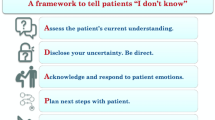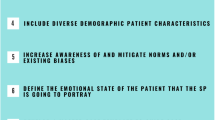Abstract
Background: The Accreditation Council for Graduate Medical Education mandates that radiology residency programs teach communication skills to residents. Objective: The purpose of this paper is to present a mnemonic, RADPED, that can be used to enhance communication in the radiology setting. It reminds the resident of the salient points to address during an imaging encounter with pediatric patients and their families for the purpose of enhancing communication. Materials and methods: Recent history and research in medical communication are reviewed. Various communication guides used by primary care physicians, such as SEGUE, and the Kalamazoo consensus statement are discussed. This methodology was adapted into a format that could be used to teach communication skills to radiology residents in the context of an imaging encounter. Results: RADPED reminds the resident to establish rapport with the patient, ask questions as to why the patient and family are presenting for the study, discuss the exam, perform the procedure, use exam distractions, and discuss the results with the referring physician and family when appropriate. This guide is available with movie clips as part of an on-line pediatric radiology curriculum, http://www.pediatricradiology.clevelandclinic.org. Summary: This simple memory aid promotes the key points necessary to optimize the radiology resident’s encounter with pediatric patients and their families.
Similar content being viewed by others
References
Summer J (1996) Medical communication: an oxymoron? Fam Med 28:614
The Association of American Medical Colleges (1999) Medical school objectives project, report III contemporary issues in medicine: communication in medicine. Association of American Medical Colleges, Washington
Korsch B (1998) Foreword. In: Kurtz S, Silverman J, Draper D (eds) Teaching and learning communication skills in medicine. Radcliffe Medical Press, Abington
Kurtz S, Silverman J, Draper D (1998) The ‘why’: a rationale for communication skills teaching and learning. In: Kurtz S, Silverman J, Draper D (eds) Teaching and learning communication skills in medicine. Radcliffe Medical Press, Abington, pp 3–13
Stewart MA, McWhinney IR, Buck CW (1979) The doctor–patient relationship and its effect upon outcome. J R Coll Gen Pract 29:77–82
Byrne PS, Long BEL (1976) Doctors talking to patients: a study of the verbal behaviour of general practitioners consulting in their surgeries. Her Majesty’s Stationary Office, London, pp 6–195
Beckman HB, Markakis KM, Suchma AL (1994) The doctor–patient relationship and malpractice. Arch Int Med 154:1365–1370
Gordon GH (2002) Defining the skills underlying communication competence. Semin Med Pract 5:21–28
Pantell RH, Lewis CC (1993) Talking with children: how to improve the process and outcomes of medical care. Med Encounter 10:3–7
Goske MJ, Yaldoo D, Hewson MA (2003) Patient care: how to communicate effectively with pediatric patients and their families during imaging studies. In: Pediatric radiology Web-based curriculum. Available at http://www.pediatricradiology.clevelandclinic.org and http://www. 139.137.40.209/peds2/pt_competency/ptcomp_page_1.htm. Cited 4 July 2004
Tates K, Meeuwesen L (2000) “Let mum have her say”: turn-taking in a doctor–parent–child communication. Counseling 40:151–162
Accreditation Council for Graduate Medical Education (2004) Minimal program requirements language. In: Outcome project: enhancing residency education through outcomes assessment. Available at http://www.acgme.org/outcome/com/compMN.asp. Cited 5 July 2004
Makoul G (2001) The SEGUE framework for teaching and assessing communication skills. Patient Educ Couns 45:23–24
Makoul G (2003) Communication skills education in medical school and beyond. JAMA J Am Med Assoc 289:93
Makoul G (2001) Bayer-Fetzer conference on physician–patient communication in medical education. Essential elements of communication in medical encounters: the Kalamazoo consensus statement. Acad Med 76:390–393
Clark W, Hewson MG, Fry M, et al (1998) Relationship-building (pocket card). American Academy on Physician and Patient. AAPP Resources. Available at http://www.physicianpatient.org/products.html. Cited 29 October 2004
Reid JR, Goske MJ, Hewson MG, et al (2004) Creating an international comprehensive web-based curriculum in pediatric radiology AJR 182:797–801
Gross R, Sasson Y, Zarhy M, et al (1998) Healing environment in psychiatric hospital design. Gen Hosp Psychiatry 20:108–114
Adubato S (2004) Breaking down barriers: humanism and the hospital environment. In: Caucus Education Corporation series. http://www.caucusnj.org/caucusnj/special-series/breaking/humanism_transcripts. pdf. Cited 28 Aug 2004
Todres ID (1993) Communication between physician, patient and family in the pediatric intensive care unit. Crit Care Med 21:S383–S386
DiBartola LM (2001) Listening to patients and responding with care: a model for teaching communication skills. Joint Comm J Qual Improvement 27:315–323
Marino RV, Kohen DP (1996) The power of words: communicating effectively with young patients. J Am Osteopath Assoc 96:410–410
Suls J, Wan CK (1989) Effects of sensory and procedural information on coping with stressful medical procedures and pain: a meta-analysis. J Consult Clin Psychol 57:372–379
Tarnowski KJ, McGrath ML, Calhoun MB (1987) Pediatric burn injury: Self-versus therapist-mediated debridement. J Pediatr Psychol 12:567–579
Acknowledgments
This work is supported by a grant from the Society for Pediatric Radiology Research and Education Foundation N. Thorne Griscom Education Award.
Author information
Authors and Affiliations
Corresponding author
Additional information
This paper was presented at the Society for Pediatric Radiology 46th annual meeting in San Francisco, California, 7–10 May 2003.
Rights and permissions
About this article
Cite this article
Goske, M.J., Reid, J.R., Yaldoo-Poltorak, D. et al. RADPED: an approach to teaching communication skills to radiology residents. Pediatr Radiol 35, 381–386 (2005). https://doi.org/10.1007/s00247-004-1356-8
Received:
Revised:
Accepted:
Published:
Issue Date:
DOI: https://doi.org/10.1007/s00247-004-1356-8




